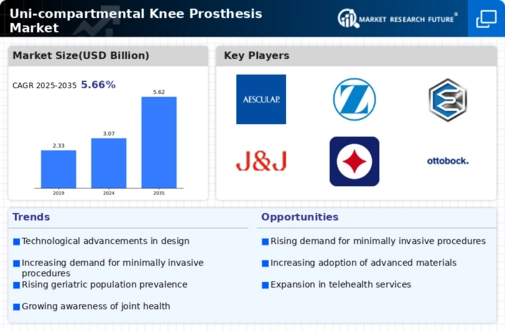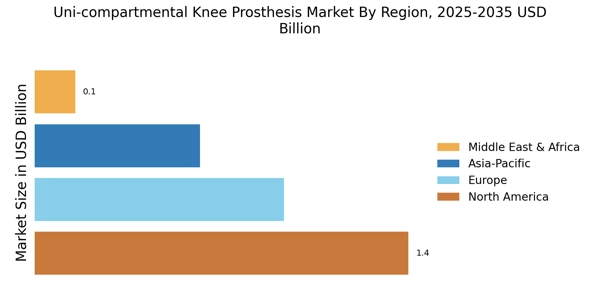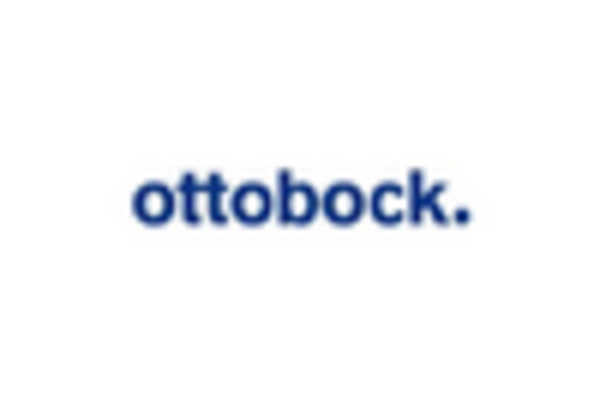Increasing Healthcare Expenditure
Rising healthcare expenditure across various regions is contributing to the expansion of the Uni-compartmental Knee Prosthesis Market. As governments and private sectors invest more in healthcare infrastructure, the availability of advanced medical technologies increases. This trend is particularly evident in developed nations, where healthcare budgets are allocated to improve surgical outcomes and patient care. Enhanced funding allows for the procurement of innovative prosthetic devices, including uni-compartmental knee prostheses. Furthermore, as patients gain access to better healthcare services, the likelihood of undergoing knee surgeries increases, thereby driving demand for these specific prosthetic solutions. The upward trajectory of healthcare expenditure is expected to positively impact the Uni-compartmental Knee Prosthesis Market.
Rising Incidence of Osteoarthritis
The increasing prevalence of osteoarthritis is a primary driver for the Uni-compartmental Knee Prosthesis Market. As populations age, the incidence of knee-related ailments rises, leading to a greater demand for effective treatment options. Reports indicate that osteoarthritis affects millions worldwide, with a notable percentage requiring surgical intervention. This trend suggests a growing market for uni-compartmental knee prostheses, as they offer a less invasive alternative to total knee replacements. The ability to target specific compartments of the knee joint may appeal to both patients and healthcare providers, potentially enhancing recovery times and overall satisfaction. Consequently, the rising incidence of osteoarthritis is likely to propel the growth of the Uni-compartmental Knee Prosthesis Market in the coming years.
Aging Population and Active Lifestyles
The aging population, coupled with a desire for active lifestyles, is a significant driver for the Uni-compartmental Knee Prosthesis Market. As individuals age, the likelihood of developing knee-related issues rises, prompting the need for effective treatment options. Interestingly, many older adults are increasingly focused on maintaining an active lifestyle, which can lead to higher demand for joint preservation techniques. Uni-compartmental knee prostheses, which allow for partial knee replacement, cater to this demographic by providing a solution that enables continued physical activity. This trend suggests that the Uni-compartmental Knee Prosthesis Market will likely see sustained growth as more individuals seek to remain active well into their later years.
Technological Innovations in Prosthetic Design
Technological advancements in prosthetic design are significantly influencing the Uni-compartmental Knee Prosthesis Market. Innovations such as improved materials, enhanced biomechanics, and advanced surgical techniques are making these prostheses more effective and appealing. For instance, the introduction of patient-specific implants and robotic-assisted surgeries has the potential to improve surgical outcomes and patient satisfaction. Data suggests that these innovations could lead to a reduction in complications and a quicker return to normal activities for patients. As technology continues to evolve, the Uni-compartmental Knee Prosthesis Market is expected to benefit from increased adoption rates, as both surgeons and patients seek the latest advancements in knee replacement solutions.
Growing Demand for Minimally Invasive Procedures
The shift towards minimally invasive surgical techniques is a notable driver for the Uni-compartmental Knee Prosthesis Market. Patients increasingly prefer procedures that promise reduced recovery times and less postoperative pain. Uni-compartmental knee arthroplasty, being less invasive than total knee replacements, aligns well with this trend. Studies indicate that patients undergoing uni-compartmental procedures often experience shorter hospital stays and quicker rehabilitation. This growing demand for less invasive options is likely to encourage healthcare providers to adopt uni-compartmental knee prostheses more widely, thereby expanding the market. As awareness of the benefits of minimally invasive techniques continues to rise, the Uni-compartmental Knee Prosthesis Market is poised for growth.


















Leave a Comment